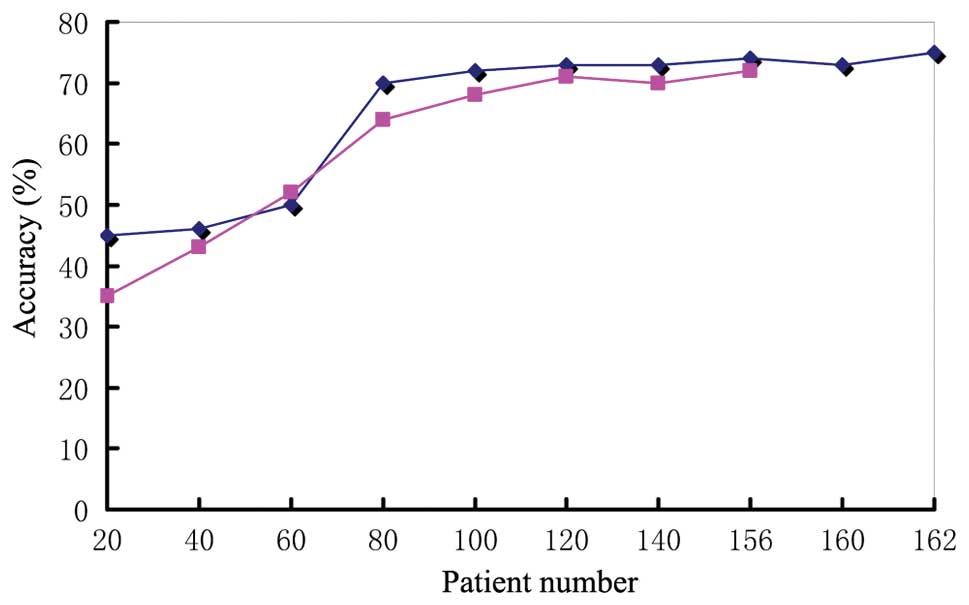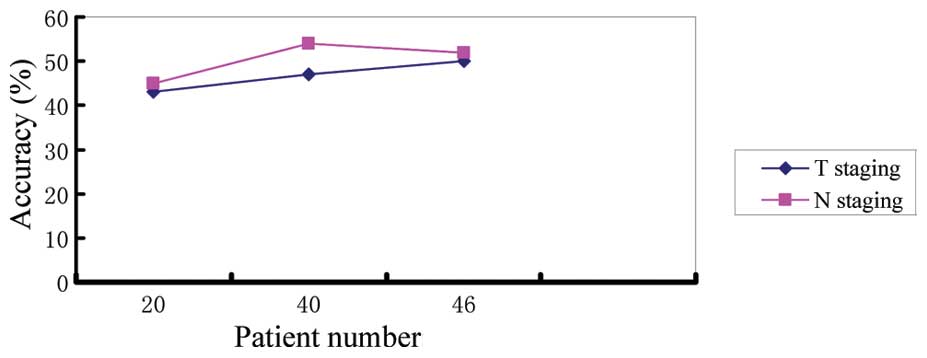|
1
|
Nedrebø BS, Søreide K, Eriksen MT, Kvaløy
JT, Søreide JA and Kørner H: Excess mortality after curative
surgery for colorectal cancer changes over time and differs for
patients with colon versus rectal cancer. Acta Oncol. 52:933–940.
2013.PubMed/NCBI
|
|
2
|
Samee A and Selvasekar CR: Current trends
in staging rectal cancer. World J Gastroenterol. 17:828–834. 2011.
View Article : Google Scholar : PubMed/NCBI
|
|
3
|
Fernández-Esparrach G, Ayuso-Colella JR,
Sendino O, et al: EUS and magnetic resonance imaging in the staging
of rectal cancer: a prospective and comparative study. Gastrointest
Endosc. 74:347–354. 2011.PubMed/NCBI
|
|
4
|
Cârţână ET, Pârvu D and Săftoiu A:
Endoscopic ultrasound: current role and future perspectives in
managing rectal cancer patients. J Gastrointestin Liver Dis.
20:407–413. 2011.PubMed/NCBI
|
|
5
|
Kav T and Bayraktar Y: How useful is
rectal endosonography in the staging of rectal cancer? World J
Gastroenterol. 16:691–697. 2010. View Article : Google Scholar : PubMed/NCBI
|
|
6
|
Puli SR, Bechtold ML, Reddy JB, et al: Can
endoscopic ultrasound predict early rectal cancers that can be
resected endoscopically? A meta-analysis and systematic review. Dig
Dis Sci. 55:1221–1229. 2010. View Article : Google Scholar : PubMed/NCBI
|
|
7
|
Hildebrandt U and Feifel G: Preoperative
staging of rectal cancer by intrarectal ultrasound. Dis Colon
Rectum. 28:42–46. 1985. View Article : Google Scholar : PubMed/NCBI
|
|
8
|
Edge S, Byrd DR, Compton CC, Fritz AG,
Greene FL and Trotti A: AJCC Cancer Staging Manual. 7th edition.
Springer; New York: 2010
|
|
9
|
Beynon J, Foy DM, Temple LN, Channer JL,
Virjee J and Mortensen NJ: The endoscopic appearances of normal
colon and rectum. Dis Colon Rectum. 29:810–813. 1986. View Article : Google Scholar
|
|
10
|
Ayuso Colella JR, Pagés Llinás M and Ayuso
Colella C: Staging rectal cancer. Radiologia. 52:18–29. 2010.(In
Spanish).
|
|
11
|
Popek S and Tsikitis VL: Neoadjuvant vs.
adjuvant pelvic radiotherapy for locally advanced rectal cancer:
which is superior? World J Gastroenterol. 17:848–854. 2011.
View Article : Google Scholar : PubMed/NCBI
|
|
12
|
Sermeus A, Leonard W, Engels B and De
Ridder M: Advances in radiotherapy and targeted therapies for
rectal cancer. World J Gastroenterol. 20:1–5. 2014. View Article : Google Scholar : PubMed/NCBI
|
|
13
|
Garcia-Aguilar J, Pollack J, Lee SH,
Hernandez de Anda E, Mellgren A, Wong WD, Finne CO, Rothenberger DA
and Madoff RD: Accuracy of endorectal ultrasonography in
preoperative staging of rectal tumors. Dis Colon Rectum. 45:10–15.
2002. View Article : Google Scholar : PubMed/NCBI
|
|
14
|
Nesbakken A, Lovig T, Lunde OC and Nygaard
K: Staging of rectal carcinoma with transrectal ultrasonography.
Scand J Surg. 92:125–129. 2003.PubMed/NCBI
|
|
15
|
Mackay SG, Pager CK, Joseph D, et al:
Assessment of the accuracy of transrectal ultrasonography in
anorectal neoplasia. Br J Surg. 90:346–350. 2003. View Article : Google Scholar : PubMed/NCBI
|
|
16
|
Lin S, Luo G, Gao X, et al: Application of
endoscopic sonography in preoperative staging of rectal cancer:
six-year experience. J Ultrasound Med. 30:1051–1057.
2011.PubMed/NCBI
|
|
17
|
Sailer M, Leppert R, Bussen D, Fuchs KH
and Thiede A: Influence of tumor position accuracy of endorectal
ultrasound staging. Dis Colon Rectum. 40:1180–1186. 1997.
View Article : Google Scholar : PubMed/NCBI
|
|
18
|
Yamashita Y, Machi J, Shirouzu K, Morotomi
T, Isomoto H and Karegawa T: Evaluation of endorectal ultrasound
for the assessment of wall invasion of rectal cancer: report of a
case. Dis Colon Rectum. 31:617–623. 1998. View Article : Google Scholar : PubMed/NCBI
|
|
19
|
Bipat S, Glas AS, Slors FJ, Zwinderman AH,
Bossuyt PM and Stoker J: Rectal cancer: local staging and
assessment of lymph node involvement with endoluminal US, CT, and
MRI - a meta-analysis. Radiology. 232:773–783. 2004. View Article : Google Scholar : PubMed/NCBI
|
|
20
|
Dworak O: Morphology of lymphnodes in the
resected rectum of patients with rectal carcinoma. Pathol Res
Pract. 187:1020–1024. 1999. View Article : Google Scholar : PubMed/NCBI
|
|
21
|
Monig SP, Baldus SE, Zirbes TK, et al:
Lymph node size and metastatic infiltration in colon cancer. Ann
Surg Oncol. 6:579–581. 1999. View Article : Google Scholar : PubMed/NCBI
|
|
22
|
Kruskal JB, Kane RA, Sentovitch SM and
Longmaid HE: Pitfalls and sources of error in staging rectal cancer
with endorectal US. Radiographics. 17:606–626. 1997.PubMed/NCBI
|
|
23
|
Knight CS, Eloubeidi MA, Crowe R, et al:
Utility of endoscopic ultrasound-guided fine-needle aspiration in
the diagnosis and staging of colorectal carcinoma. Diagn
Cytopathol. 41:1031–1037. 2013. View
Article : Google Scholar : PubMed/NCBI
|
|
24
|
Tan KK and Tsang CB: Staging of rectal
cancer - technique and interpretation of evaluating rectal
adenocarcinoma, uT1–4, N disease: 2D and 3D evaluation. Semin Colon
Rectal Surg. 21:197–204. 2010.
|
|
25
|
Orrom WJ, Wong WD, Rothenberger DA, Jensen
LL and Goldberg SM: Endorectal ultrasound in the preoperative
staging of rectal tumors: a learning experience. Dis Colon Rectum.
33:654–659. 1990. View Article : Google Scholar : PubMed/NCBI
|
|
26
|
Morris OJ, Draganic B and Smith S: Does a
learning curve exist in endorectal two-dimensional ultrasound
accuracy? Tech Coloproctol. 15:301–311. 2011. View Article : Google Scholar : PubMed/NCBI
|
|
27
|
Katsura Y, Yamada K, Ishizawa T, Yoshinaka
H and Shimazu H: Endorectal ultrasonography for the assessment of
wall invasion and lymph node metastasis in rectal cancer. Dis Colon
Rectum. 35:362–368. 1992. View Article : Google Scholar : PubMed/NCBI
|

















